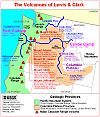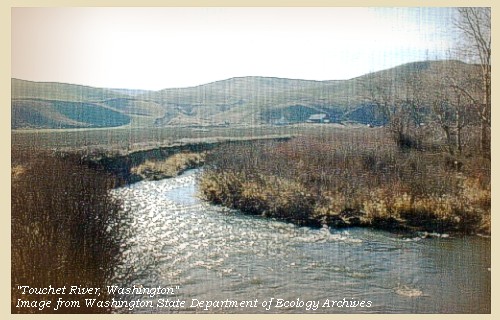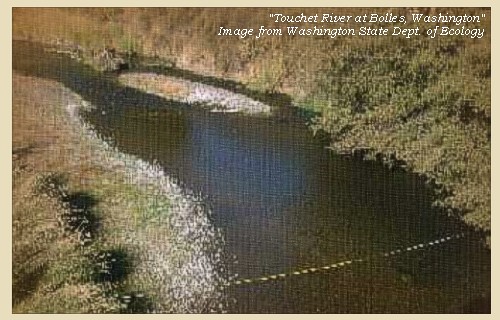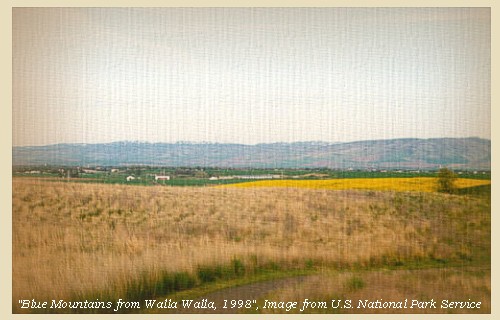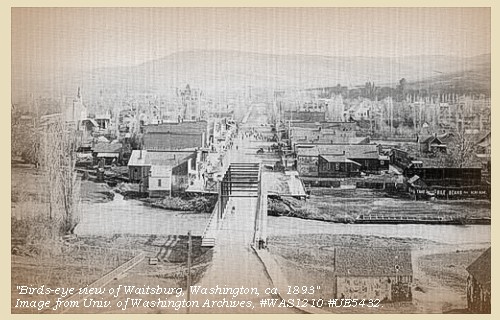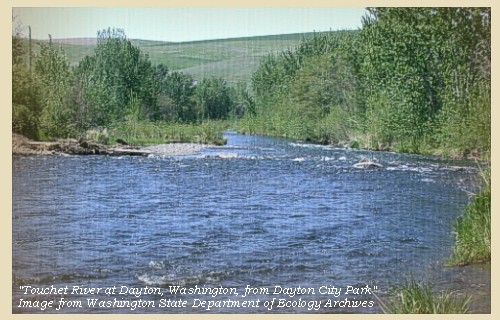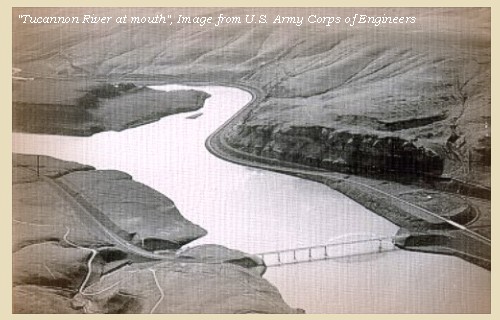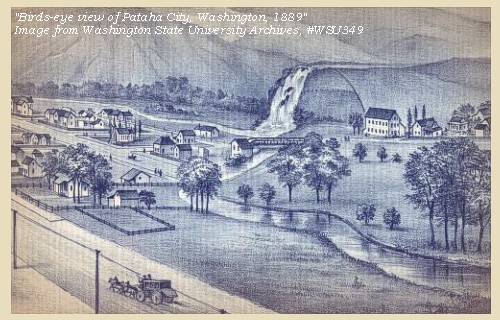The Volcanoes of
Lewis and Clark
Lewis and Clark
|
May 1 - 3, 1806 The Walla Walla Shortcut - Overland, Touchet to the Snake |
|
Home
The Volcanoes of Lewis and Clark Map of the Journey Volcanoes, Basalt Plateaus, Major Rivers, etc. The Volcanoes Mount Adams, Mount Hood, Mount Jefferson, Mount Rainier, and Mount St. Helens CALENDAR of the Journey October 1805 to June 1806 Along the Journey Pacific Northwest Maps - Columbia River, Volcanoes, Flood Basalts, Missoula Floods, Geology, etc. The Corps of Discovery The Journey of Lewis and Clark About the Reference Materials The Journals, Biddle/Allen, DeVoto, Gass, Moulton, Topo Maps, and others USGS Lewis and Clark Links Links to USGS Websites highlighting the Lewis and Clark Journey Resources Publications Referenced and Websites Visited |
PREVIOUS
April 30 The Walla Walla Shortcut, Overland, Walla Walla to the Touchet |
May 1-3
The Walla Walla Shortcut, Overland, Touchet to the Snake River Touchet River, Touchet River at Bolles, Blue Mountains, Waitsburg (Washington), Lewis and Clark Trail State Park, Dayton (Washington), Tucannon River, Pataha City and Pomeroy (Washington) |
CONTINUE
May 4 - June To the Rockies, Snake River to Long Camp |
|
Heading for Home - May 1806
The Walla Walla Shortcut - Overland, Touchet to the Snake |
| Lewis and Clark's camp of April 30, 1806, was on the Touchet River, 12 miles north of today's Touchet, Washington. |
| Thursday, May 1, 1806 |
| We collected our horses, and after breakfast set out about seven o'clock, and followed the road up the creek [Touchet River]. The low grounds and plains presented the same appearance as that of yesterday, except that the latter were less sandy. |
| "... we proceeded up the Creek on the N. E. Side through a Countrey of less sand and Some rich bottoms on the Creek which is partially Supplyed with Small Cotton trees, willow, red willow, choke Cherry, white thorn, birch, elder, [blank], rose & honey suckle. ..." [Clark, May 1, 1806] |
| At the distance of nine miles, the Chopunnish Indian, who was in front, pointed out an old unbeaten road to the left, which he informed us was our shortest route. [The Corps is at the juction of today's Greenville Road and State Highway 124.] Before venturing, however, to quit our present road, which was level, and not only led us in the proper direction, but was well supplied with wood and water, we halted to let our horses graze till the arrival of our other guide, who happened to be at some distance behind. On coming up he seemed much displeased with the other Indian, and declared that the road we were pursuing was the proper one [today's Washington State Highway 124]; that if we decided on taking the left road, it would be necessary to remain till to-morrow morning, and then make an entire day's march before we could reach either water or wood. ...... at one o'clock, and pursued our route up the creek [Touchet River], through a country similar to that we had passed in the morning. But at the distance of three miles, the hills on the north side became lower, and the bottoms of the creek widened into a pleasant country, two or three miles in extent. The timber too, is now more abundant, and our guide tells us that we shall not want either wood or game from this place as far as the Kooskooskee [Clearwater River]. We have already seen a number of deer, of which we killed one, and observed great quantities of the curlew, as well as some cranes, ducks, prairie larks, and several species of sparrow, common to the prairies. There is, in fact, very little difference in the general face of the country here from that of the plains on the Missouri, except that the latter are enlivened by vast herds of buffaloe, elk and other animals, which give it an additional interest. Over these wide bottoms we continued on a course north, 75? east, till, at the distance of seventeen miles from where we dined, and twenty-six from our last encampment, we halted for the night [Touchet River, near Bolles, west of Waitsburg]. ...... |
| "... we traviled 17 miles this evening makeing a total of 26 mls, and encamped. the first 3 miles of our afternoons march was through a Simaler Country of that of the fore noon; the Creek bottoms then became higher and wider; to the extent of from 2 to 3 miles. ... The Courses & distances of this day are N. 45o E. 9 mls. & N. 75o E. 17 Miles allong the North Side of this Creek to our encampment. ..." [Clark, May 1, 1806] |
| "... The higher we go up the creek the cotton-wood is more large and plenty; and the plains beautiful. ..." [Gass, May 1, 1806] |
|
|
|
The Camp - May 1, 1806:
On the Touchet River, near Bolles, 3 miles west of Waitsburg, Washington. |
| Friday, May 2, 1806 |
| We despatched two hunters ahead; but the horse we had yesterday purchased from the Chopunnish, although closely hobbled, contrived to break loose in the night, and went back to rejoin his companions. He was however overtaken and brought to us about one o'clock, and we then set forward. For three miles we followed a hilly road on the north side of the creek [Touchet River], opposite to a wide bottom, where a branch falls in [Coppei Creek] from the southwest mountains [Blue Mountains], which, though covered with snow, are about twenty-five miles distant, and do not appear high. |
| We then entered an extensive level bottom, [passing thru the location of today's Waitsburg, Washington] with about fifty acres of land well covered with pine near the creek, and the long-leafed pine occasionally on the sides of the hills along its banks [vicinity of Lewis and Clark State Park]. |
| After crossing the creek [Touchet River] at the distance of seven miles from our camp, we repassed it seven miles further, near the junction of one of its branches from the northeast [Patit Creek]. The main stream here [Touchet River] bears to the south, towards the mountains where it rises [Blue Mountains], and its bottoms then become narrow, as the hills are higher. [Today, Dayton (Washington) is located at the junction of Patit Creek with the Touchet River.] |
| We followed the course of this northeast branch [Patit Creek] in a direction N. 45? E. for eight and three quarter miles, when having made nineteen miles, we halted in a little bottom on the north side. The creek [Patit Creek] is here about four yards wide, and as far as we can perceive, it comes from the east, but the road here turns from it into the high open plain. The soil of the country seems to improve as we advance, and this afternoon we see, in the bottoms, an abundance of quamash now in bloom. ...... |
| "... saw to our right a range of high hills covered with timber and snow, not more than ten miles distant. ..." [Gass, May 2, 1806] |
|
|
|
The Camp - May 2, 1806:
On Patit Creek, 2 1/2 miles east of Dayton, Washington |
| Saturday, May 3, 1806 |
| We set out at an early hour, and crossed the high plains, which we found more fertile and less sandy than below; yet, though the grass is taller, there are very few aromatic shrubs. After pursuing a course N. 25? E. for twelve miles, we reached the Kinnooenim [Tucannon River]. This creek rises in the southwest mountains [Blue Mountains], and though only twelve yards wide, discharges a considerable body of water into Lewis's river [Snake River], a few miles above the narrows. Its bed is pebbled, its banks low, and the hills near its sides high and rugged; but in its narrow bottoms are found some cottonwood, willow, and the underbrush, which grows equally on the east branch of the Wollawollah [Walla Walla River]. |
| After dining at the Kinnooenim [Tucannon River], we resumed our journey over the high plains, in the direction of N. 45? E. and reached, at the distance of three miles, a small branch of that creek [Pataha Creek] about five yards wide. The lands in its neighbourhood are composed of a dark rich loam; its hill sides, like those of the Kinnooenim [Tucannon River], are high, its bottoms narrow, and possess but little timber. It increased however in quantity as we advanced along the north side of the creek for eleven miles. ...... [Cities located along this route today are Pomeroy and Pataha, Washington.] |
| We continued up the bottoms of the creek for two miles, till the road began to leave the creek, and cross the hill to the plains [following what is today Washington State Highway 12]. We therefore encamped for the night in a grove of cottonwood, after we had made a disagreeable journey of twenty-eight miles. ...... |
|
|
|
The Camp - May 3, 1806:
On the Pataha Creek, near the city of Pataha, Washington (near Pomeroy, Washington). An interpretive sign is located at the spot today. The camp was across the highway from today's sign, near the foot of the old McKeirnan grade. |
| Home | Previous | Continue |
If you have questions or comments please contact: GS-CVO-WEB@usgs.gov
June/July 2004, Lyn Topinka
The Volcanoes of Lewis and Clark Home Page | CVO Home Page

